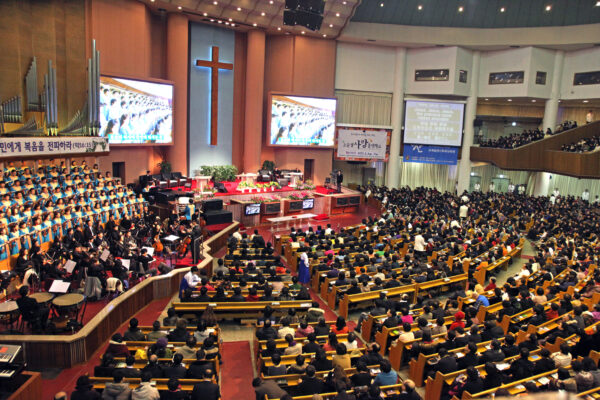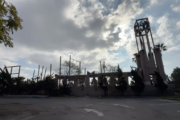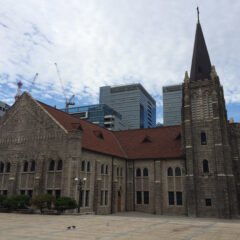Yoido Full Gospel Church is the world’s largest megachurch. When we visited the Seoul church one weekday morning last fall, I was struck by two things: First the church was full, but more importantly, it was full of mostly older women, with a few older men in attendance as well. The worship band and choir was very good, as were the production values.
Yet Yoido has had significant problems over the last few years. Its founding pastor, David Yonggi Cho, and his son were jailed for embezzling funds from the church, and its membership, while still a staggering 800,000, is declining. Of course, it could lose several thousand members a year and still be the largest church in the world for many years to come.
Our visit to Seoul last fall made me think about the similarities and differences in the ways megachurches have responded to change there and in Los Angeles.
As my colleague Andrew Johnson recently reminded us, Seoul is the megachurch capital of the world. It seems like everywhere we went there was either an existing, or under construction megachurch that made the efforts in the U.S. seem quite small. Yet as Sung Gun Kim, the leader of our Seoul research team has pointed out, megachurch attendance in Seoul has plateaued, and there is a growing dissatisfaction with their dominant presence and what they represent in Korean society.
 Yoido’s story sounds a lot like what happened at the Crystal Cathedral in Orange County, California. Founding pastor Robert Schuller built one of the first modern megachurches in the U.S. through his adept appropriation of Southern California culture, his own brand of charisma, a global media presence and large, spectacular Christmas and Easter extravaganzas.
Yoido’s story sounds a lot like what happened at the Crystal Cathedral in Orange County, California. Founding pastor Robert Schuller built one of the first modern megachurches in the U.S. through his adept appropriation of Southern California culture, his own brand of charisma, a global media presence and large, spectacular Christmas and Easter extravaganzas.
Certainly Schuller never ended up in jail, but family squabbles over church leadership, in combination with an aging membership that was not able to keep paying for the large physical plant and the Schullers’ lavish lifestyle, signaled its demise. The church sold its property to the Catholic Diocese of Orange in 2013 and now exists as a smaller congregation in a much more modest building.
In other words, however organizationally innovative Schuller and the Crystal Cathedral once was, it stagnated and ultimately failed to adapt to changing social, cultural and religious currents.
It is clear that the current megachurch model in both L.A. and Seoul is under pressure as it tries to adapt and respond to the challenges it faces. The demise of the Crystal Cathedral and the troubles experienced by Yoido Full Gospel Church might be the future of all megachurches, but we are finding interesting innovations in different megachurches in both locations.
One answer we have seen in L.A. is the performance model exemplified Hillsong, Oasis and the like. While these churches look like other megachurches, when you visit, you realize the morning worship is the whole show—well that and the impossibly beautiful young people of seemingly all races and ethnicities, who come and enjoy the show, get a little spiritual and emotional charge for the coming week, and then scurry out to brunch or whatever else they do on weekends in DTLA. This model emphasizes celebrity and performance, with little or no larger commitment required, other than a few opportunities for small group participation, all with the goal to build or maintain large attendance numbers.
Another American approach is the establishment of “franchise” locations of established megachurches in communities that are some distance from the home church. A home megachurch rents a venue in a neighboring city and organizes a Sunday morning worship service that seeks to serve that local community. Remote services are branded with the home church logos and name, and the lead pastor’s sermon is played. Think of it as quality control—you know what you’re going to get at the franchise, and although it may be tailored to local tastes, it is still the same product. The franchise model is intended to extend the reach of the home church into other communities, while maintaining and perhaps increasing its membership, all at a relatively low cost.
In Seoul, Sung Gun Kim reports that the four megachurches he is studying are taking megachurches in an almost opposite direction. The innovations in Seoul fall in primarily three areas:
- They have eschewed owning property in favor of using the money saved to operate various community outreach programs. Both franchise and performance-based megachurches sometimes rent spaces, but the intent of the churches Seoul is to free themselves up to contribute more to their communities, rather than to expand their membership base.
- In at least one case, the church explicitly limits the terms that the lead pastor, his staff and the elders can have. Thus the succession issue that plagued the Crystal Cathedral and caused scandal across several Korean megachurches is effectively solved through an innovation in church governance.
- Several innovative Korean megachurches are actively “slimming” themselves, by discouraging “switching” members who come from other churches, and by increasing the requirements for membership, thus raising the bar to full participation in the church. This is in direct contrast to either the performance or the franchise models we’ve seen in Southern California, each of which have low bars to entry and participation.
Certainly the different forms of innovation are at least partly influenced by the different cultural experiences and perspectives of Americans and Koreans. American values of individualism and individual choice can be seen through both older megachurches and in the emerging performance and franchise models. Similarly, megachurches in Seoul will likely survive their current scandals because they represent a certain status among Korean Christians, and they meet what Sung Gun Kim has called the Korean “orientation to quantity rather than quality.” The desire for a bigger, more fantastic show where the church-goer is surrounded by lots of people who are there for the same experience may be the prime similarity between megachurches in L.A. and Seoul.
Yet Kim also observed an emerging trend in Korea, which we’ve seen in L.A. too: a shift to quality over quantity. As Kim told us, “some Koreans have changed their perspective to more post-materialistic values. From their point of view, small is beautiful. Korea is also a good example of transition from materialism to post-materialism.”
Perhaps this will be the lens through which megachurches start viewing their efforts.
Oryun Community Church, another megachurch in Seoul, has extremely high production values. To see more photos, check out #ReligioninSeoul and follow @USCCRCC on Instagram.
A video posted by USC Religion & Civic Culture (@usccrcc) on
Richard Flory is the executive director of the USC Center for Religion and Civic Culture.






